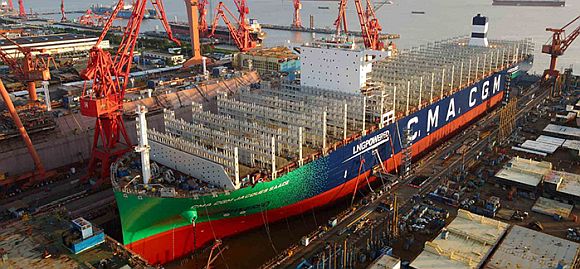 Last month, China’s Shanghai Jiangnan-Changxing Shipyard launched the CMA CGM Jacques Saadé, the first in a new fleet of nine French-flagged, 23,000-TEU, LNG-powered containerships that will join the group’s fleet in 2020 on the French Asia Line. Not only will the new ship be one of the world’s largest container ships when it goes into service, and it will also be the largest LNG powered container ship in the world. The ship will be powered by a Winterthur Gas & Diesel Ltd (WinGD) 12-cylinder X92DF dual-fuel low-speed engine, developing 63,840 kW (91,766 HP) at 80 rpm.
Last month, China’s Shanghai Jiangnan-Changxing Shipyard launched the CMA CGM Jacques Saadé, the first in a new fleet of nine French-flagged, 23,000-TEU, LNG-powered containerships that will join the group’s fleet in 2020 on the French Asia Line. Not only will the new ship be one of the world’s largest container ships when it goes into service, and it will also be the largest LNG powered container ship in the world. The ship will be powered by a Winterthur Gas & Diesel Ltd (WinGD) 12-cylinder X92DF dual-fuel low-speed engine, developing 63,840 kW (91,766 HP) at 80 rpm.
A recent study suggests that LNG can reduce the emission of Green House Gases (GHG) between 14% to 21% for 2-stroke slow-speed engines. LNG also emits zero SOx and virtually zero particulate matter. Compared to existing heavy marine fuel oils, LNG can, depending on the technology used, emit 90% fewer NOx emissions.
In addition to state of the art electronics, communications and cargo management systems, CMA CGM Jacques Saadé also features a Becker Mewis Twisted Fin® Duct to improve propeller efficiency.
CMA CGM Jacques Saadé is named in honor of Jacques R. Saade, the founding president of the CMA CGM Group, who died in June 2018 at the age of 81.
From the CMA CGA press release: By naming the world’s first LNG-powered, 23,000-TEU container ship CMA CGM JACQUES SAADE, the Group has symbolically given the name of its Founder to its future flagship. A visionary entrepreneur, Jacques Saadé built CMA CGM into one of the world’s leading maritime shipping companies, while maintaining its family dimension and strong values. In this way, he left a lasting mark on the entire shipping industry.
During the launch event, Rodolphe Saadé, Chairman and Chief Executive Officer of the CMA CGM Group, said: “With the launching of the first 23,000-TEU ship powered by Liquified Natural Gas, we demonstrate that energy transition can be effectively successful in our industry if all the players work together. It paves the way to a global shipping approach where economic growth and competitiveness can coexist with sustainability and the fight against climate change.”
The video below is a time-lapse view of the construction of the Jacques Saadé.

It seems that more of these newer container ships appear to be using cell guides above deck.
I wonder if they have been in use long enough for data to have revealed whether they actually reduce container (overboard) loss.
I know there are several competing guide system manufacturers and wonder whether existing shore based cranes have to be modified in any way to accommodate one or the other, if only to achieve maximum productivity?
hi thanks for the advice and information 🙂